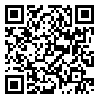Volume 12, Issue 2 (2021)
JHS 2021, 12(2): 83-112 |
Back to browse issues page
Download citation:
BibTeX | RIS | EndNote | Medlars | ProCite | Reference Manager | RefWorks
Send citation to:



BibTeX | RIS | EndNote | Medlars | ProCite | Reference Manager | RefWorks
Send citation to:
Allahyari F, azagh M, Kajbaf A A. Explaining the Formation and Causes of the Movements borazbandae, Sanbad, Isaac Turk, Stadsys, Al-Mogana and Babak Khorramdin (Emphasizing on the theory of relative deprivation Ted Robert Geer). JHS 2021; 12 (2) :83-112
URL: http://jhs.modares.ac.ir/article-25-41326-en.html
URL: http://jhs.modares.ac.ir/article-25-41326-en.html
1- , f.allahyari@ltr.ui.ac.ir
2- PhD Student in History of Iran after Islam University of Isfahan
2- PhD Student in History of Iran after Islam University of Isfahan
Abstract: (2209 Views)
Abstract
Social movements are a fundamental issue in theories of revolution that have sought to explain them because of the importance of different theories. Lashkar-e Bani Abbas raised the level of value expectations of social classes with egalitarian slogans, this was while the level of people's value ability did not change much and people suffered from frustration and relative deprivation. Important variables, including economic, religious, and participatory values, led to the expansion of these movements. the size of the movements also affected the control of coercion by the government and the opposition and it finally made the movements. The present article tries to focus on the formation and causes of the movements of Barazbandeh, Sanbad, Ishaq Turk, Ostadsis, Al-Muqna and Babak Khorramdin. Using the method of historical and sociological analysis and examining the content of historical and sociological works, in the light of the theory of relative deprivation, this article examines the formation and causes of these movements.
Social movements are a fundamental issue in theories of revolution that have sought to explain them because of the importance of different theories. Lashkar-e Bani Abbas raised the level of value expectations of social classes with egalitarian slogans, this was while the level of people's value ability did not change much and people suffered from frustration and relative deprivation. Important variables, including economic, religious, and participatory values, led to the expansion of these movements. the size of the movements also affected the control of coercion by the government and the opposition and it finally made the movements. The present article tries to focus on the formation and causes of the movements of Barazbandeh, Sanbad, Ishaq Turk, Ostadsis, Al-Muqna and Babak Khorramdin. Using the method of historical and sociological analysis and examining the content of historical and sociological works, in the light of the theory of relative deprivation, this article examines the formation and causes of these movements.
Keywords: Relative Deprivation, Classes, borazbandae, Sanbad, Isaac Turk, Stadsys, Al-Mogana and Babak Khorramdin.
Send email to the article author
| Rights and permissions | |
 |
This work is licensed under a Creative Commons Attribution-NonCommercial 4.0 International License. |







